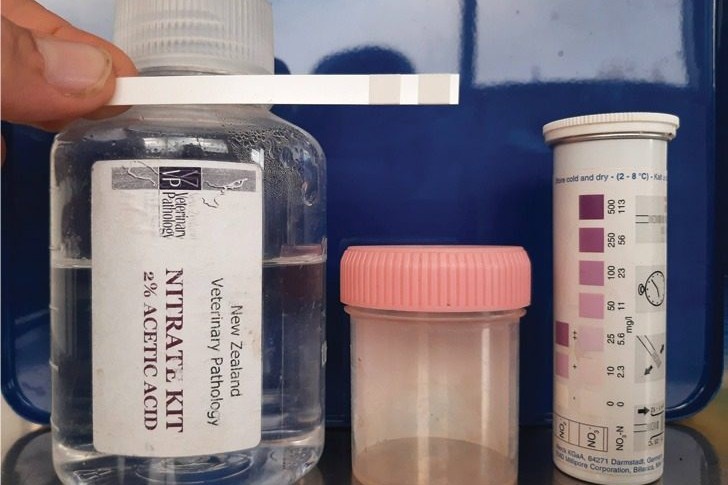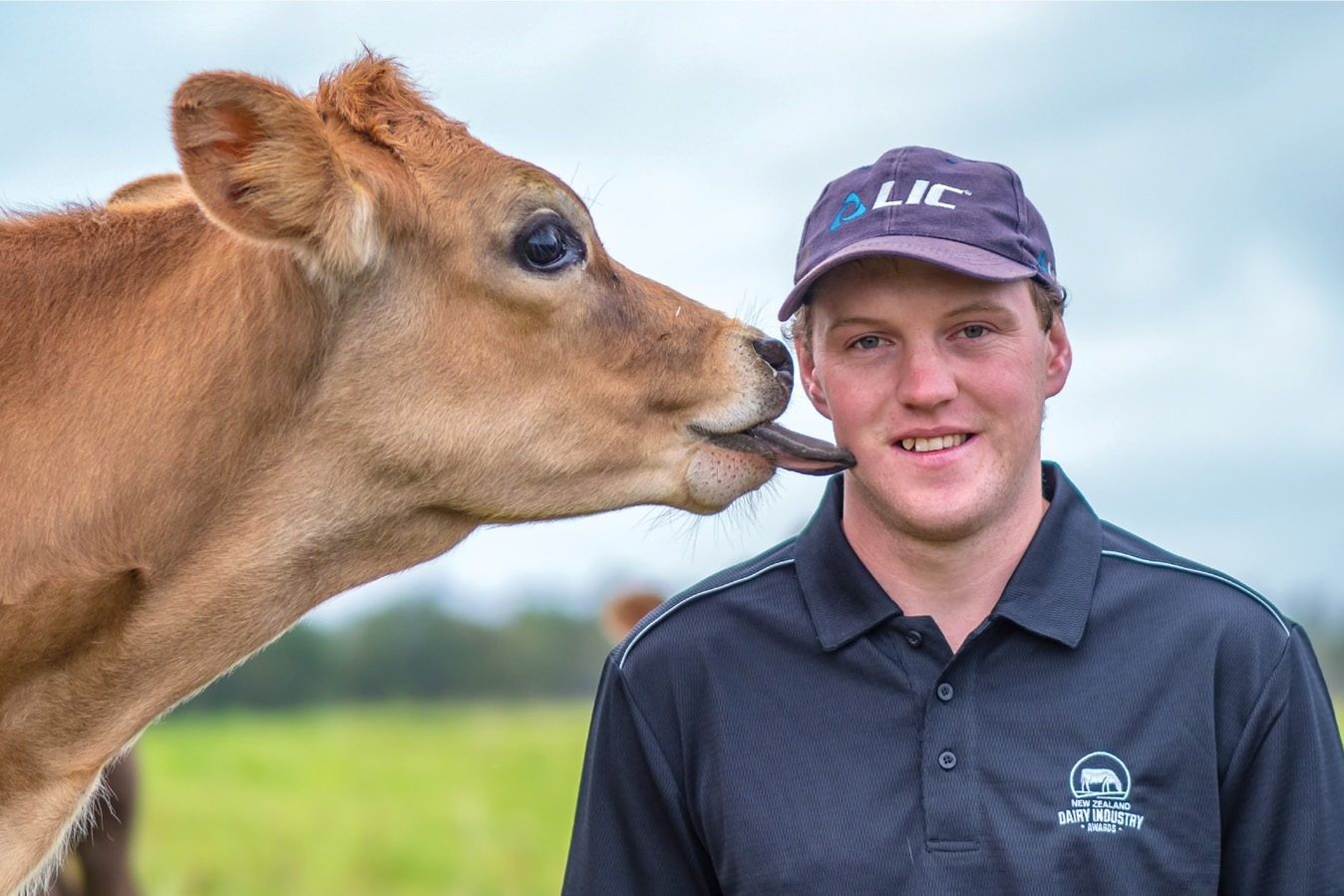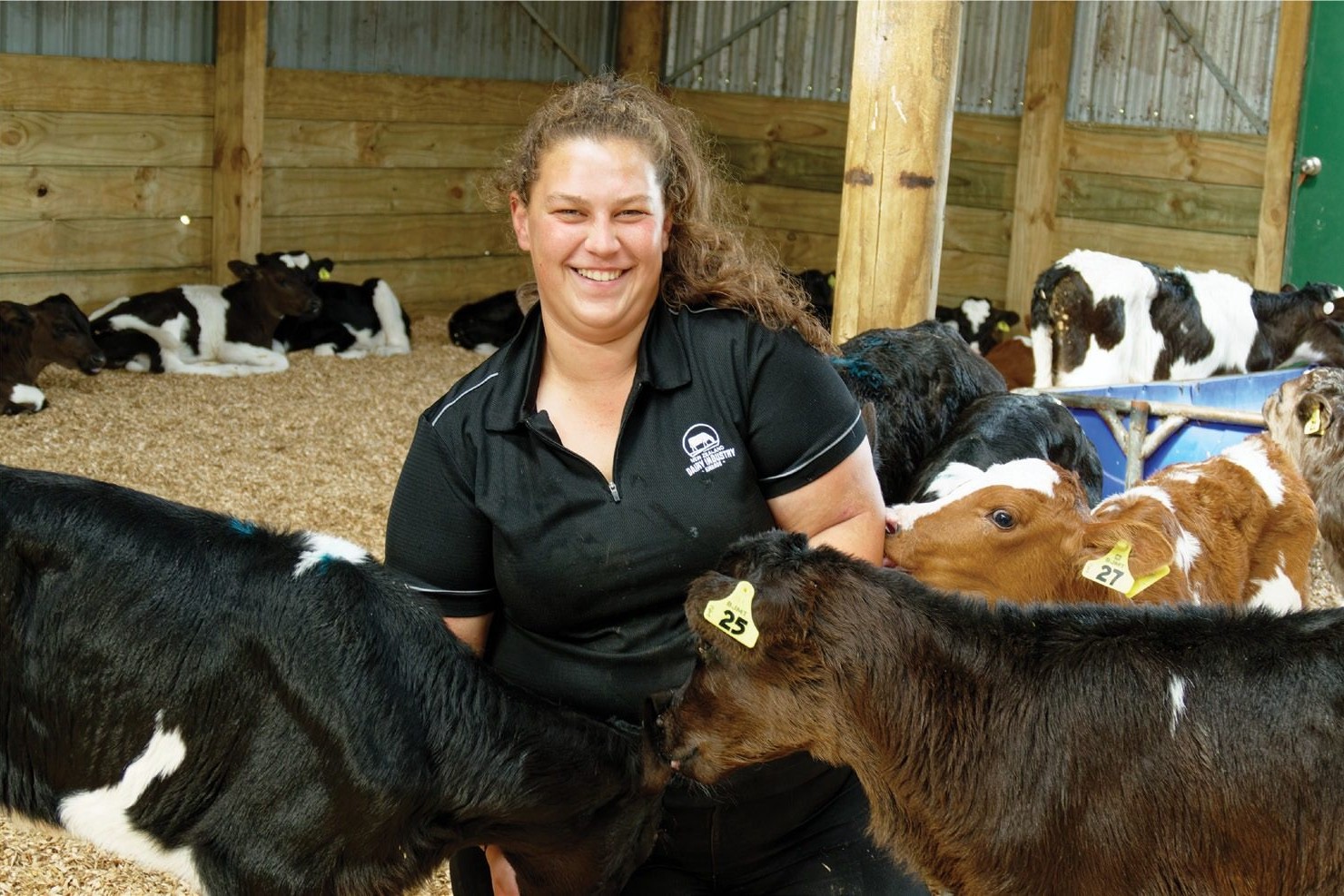Words by Jackie Harrigan, photo by Ross Nolly
John Wyatt has spent the last 14 years working and learning in the dairy industry. He studied his way through all of the Primary ITO training from Level 2 to the Diploma of Agribusiness Management and now has taken out the Dairy Industry Award trifecta – winning all three categories in three different regions – a feat not thought to have been achieved before. Originally from Dannevirke, John won the 2009 Hawkes Bay/Wairarapa Dairy Trainee of the Year category and was named the 2015 Manawatu Farm Manager of the Year.
This year he completed the winning streak by winning the 2021 Taranaki Share Farmer of the Year.
John and his wife Kristina, who is a vet working for Taranaki Vet Centre in Stratford, run a low-input system 2 operation, for the past four years contract milking for Mike Hammond on his 106ha 315-cow Auroa property. Last year, they welcomed Caleb into their family, with Kristina taking maternity and calving leave, timed to be able to help John with the calving and calf rearing – while also caring for a new baby.
“We were lucky to have our parents come and help – my mum came for a week, and then John’s mum came for a week. I would be out on the farm and they would ring me whenever the baby woke so I could rush home and feed him.”
Not most people’s idea of maternity leave, but Kristina revelled in the chance to actually work alongside John and learn about the farm from inside the gumboots – rather than in the vets overalls.
“I had worked on different farms during my vet training but that stint was so great, I really got to see exactly what goes on, and we found that we actually work really well together.”
“Calving is actually my favourite time of the year – I don’t mind getting up at 2am to calve a cow.”
Focused couple
They are a very focused couple who love to learn, Kristina is working her way through a Postgraduate Certificate in Science and Tech through the Massey Vet faculty by distance learning ticking off a mastitis paper and a lameness paper thus far.
John attends lots of discussion groups where he continues to learn.
In their low input operation, they don’t buy in any supplement except for a little PKE for calves – grass really is king, and maintaining quality and quantity is the key to production for John.
He has spent years finessing his grass production knowledge and practice, and says he is proud of setting the farm record for production on three different farms, crediting attention to detail and focusing on profit not production as core strengths of their business.
He puts a huge amount of attention into hitting residuals, and controlling the grass quality – topping in spring after the cows if necessary to reset the levels on the 40+ year old pastures, which he says can be pretty unforgiving.
“I aim to only top each paddock once, and usually do about 90% of the farm over the October/November period.”
Although the pastures are old, they are in good heart and very robust through the winter – handling having the cows wintering on them.
“We are looking at the opportunities of undersowing a new hybrid into some paddocks but we are growing over 14t DM/ ha and with the new turnip crop adding in 16t/ha we are reaping the benefits of that late summer production.”
Measuring the pasture is done with a C-Dax tow-behind every 10 days in the spring stretching out to fortnightly at other times of the year and John makes good use of the data – constantly updating and consulting his feed wedge and feed budget for grazing plans.
Putting more focus on the cow body condition scoring (BCS) has allowed them to boost their spring production through to December and the turnips in summer have built autumn production and allowed them to protect that condition going into the winter.
Kristina is passionate about mastitis, hence the extra study on its prevention and treatment.
One strategy is to milk any high somatic cell count (SCC) cows last so they don’t transfer any bugs to other cows. Making sure teat spraying is completed well all season is another simple but important task.
While they weren’t particularly looking for technology in the dairy shed when they went to work for Mike Hammond, they are now finding the YieldSense and CellSense technology in the rotary dairy shed invaluable, along with ProTrack and auto cup removers that allow John, or someone else, to milk by themself.
The YieldSense system is on every bail, and the CellSense on every third one, so that cows are production measured every milking and cell counted every third milking.
“The technology means we can keep a good eye on cell counts and if there is any increase, we will strip the whole herd and find it,” John said.
“It’s usually 50:50 as to whether the CellSense system finds it or whether I do,” he added. Kristina is also able to whip a sample into the lab at work and culture it to identify a mastitis bug or check if a cow has not cured and to plan the drug treatment.
Their attention to detail has earned them a SCC average of 80,000 for the season.
There is a saving on not having to use a herd testing service, but John says there may be a small price to pay on the impact on breeding worth (BW) and production worth (PW) of not feeding the herd testing info into the LIC database.
Positioning a mirror above the cups-on is great for checking tail paint at mating and John says he can punch the numbers of cycling cows into the ProTrack and the cows are drafted out automatically at the end of milking.
“Now that we have had the technology we wouldn’t like to go back to not having it, but I admit it took me a while to trust it at the beginning,” John laughs.
“I can set up alerts for three titters, high SCC or colostrum cows, it’s a great system.”
Next on John and Kristina’s technology wish list is cow collars – John says they have been doing some research and Kristina has been scouting out the different ones when she visits farmers around the district.
“They would be great for heat detection and just to pick up cow health problems early.”
Taking the next step
The Wyatt’s have been having conversations with their farm owner about investing in the herd and taking the next step into sharemilking, which will happen next season.
The couple have been breeding towards a fully DNA tested A2 herd and are pleased with the BW/PW of 124/144, lifting by a couple of percentage points each year by retaining higher BW calves from higher genetic merit cows.
For biosecurity they are using all AB, with 5 weeks AB for replacements, 2 weeks short gestation (SG) Hereford as a marker and then SG crossbred for the other four weeks.
The short gestation crossbred semen brings late calvers forward twice as much as the SG Hereford, John says, and at the moment they are constrained for calf rearing shed space so rear their 70-80 replacements and any well-marked Herefords but they are forced to sell bobby calves from the later calving cows.
“That’s one thing on our wishlist to work on changing as we can see value in retaining more beef calves for rearing and selling – it’s an opportunity for us.”
John and Kristina have overhauled the health and safety policies since being on the Auroa farm creating a farm safety plan and WorkSafe policies forming a living document.
Health and safety is an attitude, they say.
“Getting home safe is no accident – we have a staff induction process, standard operating procedures and well documented step-by-step illustrated processes on the farm dairy wall.”
“Everyone wears helmets on motorbikes and Caleb is always restrained in a car seat in our wee four-wheel drive when he is on the farm.”
John and Kristina set their business and life values and vision in a 2019 Mark and Measure course and mapped out their progression from that vision. Focus on detail, attention to budgets and spending and lots of number crunching of options and scenarios has kept them on track in their business growth. But their dual emphasis on life balance and community contribution has seen them playing squash and hockey, mountain biking and cake decorating, shooting and ballroom dancing (before baby) and making sure they take regular family holidays along with contributing to local school governance and the Farming for the Future sustainability group.
They appreciate the willingness of their farm owner to discuss and consider their new initiatives and his openness to sensible and financially-sound change. In addition, they are loving the area they have found themselves living in with the lifestyle that 15 minutes to the mountain and 15 minutes to the beach affords and the business opportunities that a great grass growing climate and forgiving soils allows. Appreciating the farm upbringing they can offer their children, they are very happy to stay building their equity where they are for the next five years and then review their options.
Taranaki Share Farmer of the Year:
DairyNZ Human Resources Award – Nestor Eligado
Ecolab Farm Dairy Hygiene Award – Sophie Parker and Matthew Thomas
Federated Farmers Leadership Award – Kelsey and Josh Thompson
Honda Farm Safety, Health and Biosecurity Award – John Wyatt
LIC Recording and Productivity Award – Kelsey and Josh Thompson
Meridian Farm Environment Award – Kelsey and Josh Thompson
Ravensdown Pasture Performance Award – John Wyatt
Westpac Business Performance Award – John Wyatt





